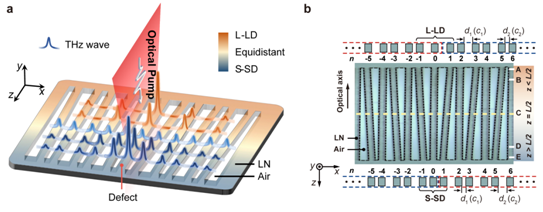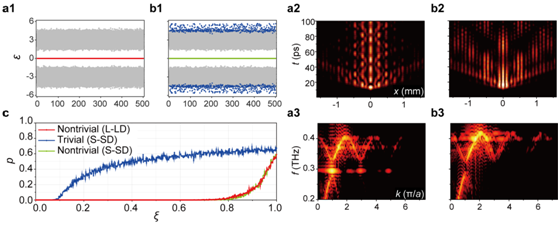Nonlinear generation and topologically-tuned confinement of THz waves is demonstrated and directly visualized in a single photonic chip. The distinctive features of the topological interface states under chiral perturbations are analyzed. This work offers a flexible and convenient way to tune the confinement and properties of THz waves using topological structures, which may open an avenue towards the implementation of stable and compact THz photonic integrated circuits for various applications.
Compact terahertz (THz) functional devices are greatly sought after for high-speed wireless communication, biochemical sensing, and non-destructive inspection. However, controlled THz generation, along with transport and detection, has remained a challenge especially for chip-scale devices due to low-coupling efficiency and unavoidable absorption losses. To address this challenge, a new paper published in Light Science & Application, by a team of scientists, led by Professor Jingjun Xu and Zhigang Chen from the MOE Key Laboratory of Weak-Light Nonlinear Photonics, TEDA Institute of Applied Physics and School of Physics, Nankai University, Tianjin 300457, China, and co-workers havedemonstrated nonlinear generation and topologically tuned confinement of THz waves in an engineered lithium niobate chip forming a wedge-shaped Su-Schrieffer-Heeger lattice. Such topological control of THz waves may bring about new possibilities in the realization of THz integrated circuits, promising for advanced photonic applications.
The experiment results show topologically tuned THz-wave confinement in a single photonic chip, as they stated in the text:
“The above experimental results clearly demonstrate that the generated THz waves can be strongly confined near the center defect in both the L-LD and S-SD regions (Fig. 2, second row) away from the transition point (marked in Fig. 1b). The significant difference between these two regions is that the localization of 0.3 THz in the L-LD (marked as A, B in Fig. 2) has topological protection, whereas the observed localization of 0.42 THz in the S-SD (marked as D, E in Fig. 2) results from trivial defect modes. Upon nonlinear excitation, the THz waves are generated and switched from a topological defect mode to a bulk mode, and then to a trivial defect mode, exhibiting tunable confinement as well as the THz topological mode population along the LN chip.”

Fig. 1. Experimental realization of topologically controlled THz localization.
(a) Illustration of nonlinear generation and confinement of THz-wave in an SSH-type microstructure. The LN structure undergoes a transition from L-LD, through equidistant, to S-SD regions along the +z axis, illustrated by colors shaded from orange into blue.The polarization of the THz electric field generated and that of the optical pump beam are all along the direction of the LN crystalline axis (z-axis). (b) Microscope image of the LN array structure fabricated by fs-laser writing.

Fig. 2. Experimental (top two rows) and numerical (bottom two rows) demonstrations of topologically controlled THz confinement in the LN chip from L-LD though equidistant, and then to S-SD regions of the wedge-shaped SSH photonic lattice. A, B, C, D and E correspond to locations marked in Fig. 1(b).
(a1-e1) Measured spectra at the corresponding positions. (a2-e2) Energy distribution of the modes showing different confinement of the generated THz waves in the LN chip. (a3-e3) Simulated x-t diagrams showing the THz waves evolution in different regions, where (a4-e4) are the corresponding spectra. The lattice sites are illustrated by white tick marks in (a3-e3), and a in (a1, a4) is the lattice constant for the corresponding L-LD structure.
They have further analyzed the distinction between topologically nontrivial and trivial defect modes:
“For the L-LD case, the eigenvalue of a topological defect mode is robust and isolated from the bulk modes under perturbations (Fig. 3a1). In the S-SD structure, even though a topological mode is still robust, the trivial defect mode excited in Figs. 2d, e is severely affected by perturbations (Fig. 3b1). Direct comparison of numerically simulated x-t diagrams and the differences in the corresponding spectra of the THz field between the L-LD and the S-SD structures under perturbations also confirm the features typically associated to topological protection, as shown in Figs. 3a2, a3 and Figs. 3b2, b3. Therefore, the topological structures can be employed to suppress or eliminate scattering loss and decay of the THz waves. As shown in Fig. 3c, even at a high perturbation ratio (60%), the THz field confinement still persists due to the robustness of the nontrivial topological mode. On the other hand, under the same experimental conditions (see the Supplementary Information for detail), half of the perturbation sets show coupling between the trivial defect mode and the bulk mode. ”
More details can be found in the text.

Fig. 3. Distinction between topologically nontrivial and trivial defect modes under chiral perturbations.
This work was supported by the National Key Research and Development Program of China, Higher Education Discipline Innovation Project, the National Natural Science Foundation of China, the China Postdoctoral Science Foundation, as well as the NSERC and the CRC program in Canada.
Topologically tuned terahertz confinement in a nonlinear photonic chip, Light: Science & Applications,11, 152 (2022). https://doi.org/10.1038/s41377-022-00823-7



